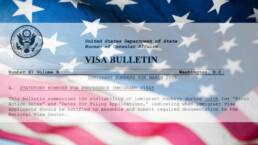When you’re told you are subject to a green card backlog, especially in the context of employment-based immigration, it means there is a delay or wait time before you will receive your physical green card. The U.S. limits the number of employment-based green cards issued each year, and the backlog occurs because the demand for green cards often far exceeds the available supply across different preference categories (e.g. EB-1, EB-2, EB-3). Being “subject to a backlog” means that your “priority date” is not yet current, and you must wait until it becomes current before you can file an Adjustment of Status application or attend an Immigrant Visa interview at a U.S. Consulate or Embassy abroad.
The Visa Bulletin
The Visa Bulletin is a monthly publication by the U.S. Department of State that provides an updated waiting list for immigrants who are subject to numerical limits on immigration to the United States, particularly in the family-sponsored and employment-based categories. The Visa Bulletin is a crucial tool for immigrants and their attorneys to understand where they stand in the queue for the green card.
The Visa Bulletin breaks down the availability of immigrant visas according to:
- Priority Date: The “priority date” serves as your “place in line” within the backlog, and it is established either on the date your PERM Labor Certification was filed with DOL, or if exempt from PERM, the date your I-140 petition was filed with USCIS.
- Preference Categories: Different categories of employment-based immigrants are allocated different numbers of visas each year.
- EB-1 (First Preference): This category is reserved for individuals with extraordinary ability in the sciences, arts, education, business, or athletics; outstanding professors and researchers; and multinational managers or executives who have been employed by the same employer abroad and are being transferred to the U.S. The EB-1 category typically has shorter waiting times due to its high qualification standards; historically, the Visa Bulletin typically shows that visas are available without significant backlogs, except for applicants from countries with high demand.
- EB-2 (Second Preference): Targeted at professionals holding advanced degrees (beyond a baccalaureate degree), or persons with exceptional ability in the sciences, arts, or business that will substantially benefit the U.S. national interest. The EB-2 category can experience backlogs, particularly for applicants from countries with a high volume of applicants. However, it’s generally faster than the EB-3 category. National Interest Waivers (NIW) are part of this category, allowing some individuals to bypass the labor certification requirement if they can demonstrate their employment in the U.S. would greatly benefit the nation.
- EB-3 (Third Preference): This is for professionals holding jobs that require at least a U.S. bachelor’s degree, for skilled workers holding jobs requiring at least two years of training or experience, and for other workers in positions that require less than two years of training or experience. This category often faces the longest backlogs, especially for applicants from highly populous countries, due to the broader eligibility criteria and higher demand.
- Per-Country Caps: There are also limits on the number of visas that can be issued to natives of any single foreign country in a fiscal year to ensure immigration is distributed broadly and does not favor any one country too heavily. Foreign nationals born in India and China often see longer backlogs due to the high volume of applicants from these countries.
The Visa Bulletin features two main charts for family-sponsored and employment-based visa applicants:
- The “Final Action Dates” chart indicates when the physical green card can actually be issued based on an applicant’s priority date. In the employment-based context, if your priority date is on or before the Final Action date listed in the Visa Bulletin for your specific category and country of chargeability, your application is ready for the final adjudication phase. This means USCIS can approve your Adjustment of Status application and issue the physical green card if you’ve filed an I-485 application from within the U.S. Alternatively, if Consular Processing abroad, you will be scheduled for your final immigrant visa interview at a U.S. Consulate or Embassy assuming you are documentarily qualified with the National Visa Center (NVC). In sum, the Final Action Dates chart is directly tied to green card/immigrant visa availability – it shows when a visa number is available for an applicant’s green card to be issued.
- The “Dates for Filing” chart is considered a bit more forward-looking, indicating when Adjustment of Status applicants may submit their application, even if the final action date isn’t current yet. These dates are generally an early readiness indicator, prompting applicants to prepare and submit documentation so that once a green card becomes available (as indicated by having a current priority date under the Final Action Dates chart), their pending Adjustment applications can be quickly processed.
Adjustment of Status (Form I-485) applicants must check USCIS announcements following each monthly Visa Bulletin release. When USCIS determines that there are more green cards available in a particular category than there are applicants, it may allow the use of the “Dates for Filing” chart. This lets a broader group of applicants get their AOS applications in the queue early, even if a final green card number is not immediately available for final action on their case. Having a pending AOS can be particularly beneficial for applicants because it allows them to receive a receipt notice from USCIS, apply for work authorization and travel documents for themselves and their immediate family members, and generally advance in the process towards obtaining LPR status.
However, if USCIS decides that the number of available green cards is closer to the number of applicants who have reached the final stages of processing, it may require applicants to use the less favorable “Final Action Dates” chart. This approach is more conservative, aiming to prevent an excess of pending applications that cannot be finalized due to unavailability in green card numbers.
Understanding and monitoring the Visa Bulletin is essential for planning immigration strategies, especially in navigating through the green card process. It helps applicants estimate the time frames for when they might move to the next step of their green card journey. Contact us if you need help.
Ready to have Berardi on your side?
Whether you’re a business looking to hire or a professional hoping to relocate, immigration law can be complicated. But you don’t have to do it alone. Put our experience to work for you.



